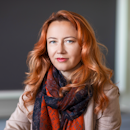Wave Localization and the Hidden Structure of Disorder
- Speaker
-
 Svitlana Mayboroda, Ph.D.McKnight Presidential Professor, University of Minnesota
Svitlana Mayboroda, Ph.D.McKnight Presidential Professor, University of Minnesota
The 2025 lecture series in mathematics and computer science is “Discovering Mathematics Through Computers.” Computers are revolutionizing the way we explore mathematical concepts. In this series, mathematicians will discuss how computational techniques are enabling new approaches to developing conjectures and proving and verifying theorems. Topics will include algorithmic number theory, formal proof verification and the role of machine learning and computational simulations in uncovering new mathematical insights. These lectures will highlight the synergy between mathematics and computer science, illustrating how digital tools expand mathematical knowledge’s frontiers.
2025 Lecture Series Themes
Biology: Mechanisms of Evolution
Mathematics and Computer Science: Discovering Mathematics Through Computers
Presidential Lectures are a series of free public colloquia spotlighting groundbreaking research across four themes: neuroscience and autism science, physics, biology, and mathematics and computer science. These curated, high-level scientific talks feature leading scientists and mathematicians and are designed to foster discussion and drive discovery within the New York City research community. We invite those interested in these topics to join us for this weekly lecture series.
At the forefront of modern technology, matter structured at the nanometer and atomic levels increasingly reveals its wavelike nature. In recent years, cutting-edge experiments with ultracold atoms pushed the limits of fundamental physics, created new states of matter and offered the possibility of controlling quantum entanglement, with major potential applications in cryptography and quantum computing. The electronic waves confined in quantum wells yielded high-efficiency light-emitting diodes, which are about to revolutionize the energetics of lighting. At these scales, even the slightest disorder or irregularity can trigger one of the most puzzling and ill-understood phenomena: wave localization.
But what is wave localization? In this Presidential Lecture, Svitlana Mayboroda will discuss how it is an astonishing ability of physical systems to maintain vibrations in a small portion of the original domain, preventing extended propagation. One should not, however, think solely in terms of mechanical vibrations. Light is a particular example of an electromagnetic wave, Wi-Fi signals are waves, sound is a pressure wave and, since the rise of quantum physics, even matter is perceived as waves. Whether wanted or unwanted, known or ignored, exploited or only sustained, the localization of these waves plays a paramount role in our everyday life and the science and technology of the future. Mayboroda will discuss the intricate nature of this phenomenon, the perplexing rules of confinement, the geometry perceived by the human eye, and the very different geometry that guides the propagation of waves or the formation of free boundaries.
